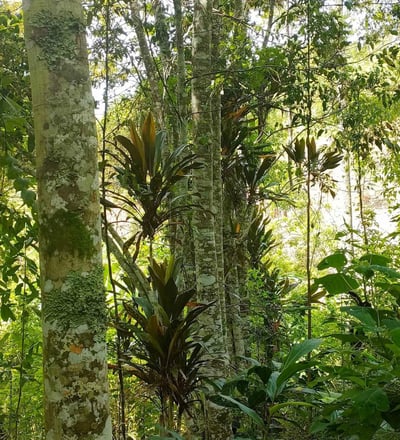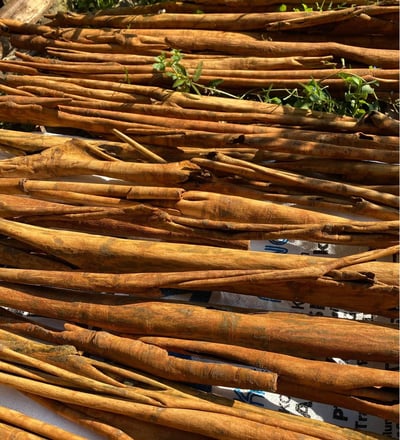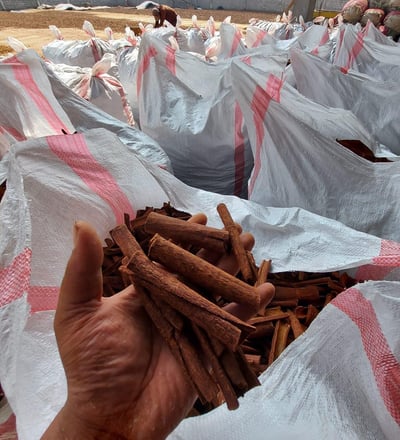Cinnamon
Benefits
Cinnamon is a highly prized spice known for its sweet, warm flavor and numerous health benefits. It contains powerful antioxidants like polyphenols, which help fight oxidative stress and reduce inflammation. Cinnamon is also known for its ability to lower blood sugar levels, making it beneficial for people with type 2 diabetes. The spice has antimicrobial properties, which can help fight bacterial and fungal infections. Additionally, cinnamon is believed to improve heart health by lowering cholesterol levels and reducing the risk of cardiovascular disease. In traditional medicine, it has been used to alleviate symptoms of digestive issues, colds, and flu. Its distinctive aroma also makes it popular in aromatherapy for its calming effects.
History in Indonesia
Cinnamon has a rich history in Indonesia, particularly in the region of Sumatra, where Ceylon cinnamon (Cinnamomum verum) and cassia cinnamon (Cinnamomum cassia) have been cultivated for centuries. The spice was highly valued in ancient trade routes, with Indonesia becoming one of the key suppliers to markets in Asia, the Middle East, and Europe. During the colonial period, the Dutch East India Company (VOC) played a significant role in the cultivation and export of cinnamon from Indonesia, particularly from the island of Sri Lanka (Ceylon) and Sumatra. The spice was in high demand in Europe, where it was used not only in cooking but also in medicine and perfumery. Today, Indonesia remains one of the world's leading producers of cinnamon, with its spices continuing to be highly valued on the global market.
Cultivation and Growth
Cinnamon trees thrive in tropical climates, making Indonesia's warm and humid environment ideal for their growth. The trees are typically grown in the highland regions of Sumatra and Java, where the fertile soil and abundant rainfall provide optimal conditions. Cinnamon trees can grow up to 10-15 meters (33-50 feet) in height and require well-drained soil and partial shade. The bark is the most valuable part of the tree and is harvested once the tree reaches maturity, usually after 2 to 3 years for Ceylon cinnamon and 6 to 10 years for cassia cinnamon. The outer bark is removed to expose the inner bark, which is then carefully peeled, dried, and rolled into quills or sticks. The quality of cinnamon is determined by the thickness of the bark and the intensity of its flavor and aroma.
Harvesting Season
Cinnamon is typically harvested twice a year, during the dry season, which in Indonesia is from May to October. The timing of the harvest is critical to ensure the best quality of cinnamon. After the bark is harvested, it is sun-dried, during which it curls into the familiar quills or sticks. The drying process enhances the flavor and aroma of the spice. The quality of the final product depends on the precision and care taken during the harvesting and drying processes.
Shelf Life
Cinnamon has a long shelf life when stored properly. Whole cinnamon sticks can last up to 2 to 3 years if kept in a cool, dry place away from direct sunlight. Ground cinnamon, however, has a shorter shelf life, typically around 6 months to a year, as it can lose its flavor and potency more quickly when exposed to air. To maintain its freshness, cinnamon should be stored in an airtight container.
Global Market Impact
Cinnamon is one of the most popular spices globally, with a strong presence in both the culinary and medicinal markets. Indonesia is one of the largest producers and exporters of cinnamon, supplying a significant portion of the world's demand. Cinnamon is widely used in the food industry, particularly in baking, confectionery, beverages, and spice blends. It is also used in the production of essential oils, cosmetics, and traditional medicines. The global demand for cinnamon continues to grow due to its versatility and health benefits. However, the market is subject to fluctuations due to factors such as climate conditions, production yields, and trade regulations, which can impact supply and pricing. Despite these challenges, cinnamon remains a highly valued spice in the global market, known for its rich flavor, aroma, and numerous health benefits.








